Application notes
How to predict spreadability in powder bed based AM?
Each layer is then partially sintered or melted with an energy beam to build the parts. The layer thickness defines the vertical resolution of the printer; a thin layer leads to a better resolution...
In collaboration with
Introduction
Generalities
Granular materials and fine powders are widely used in industrial applications. To control and to optimize processing methods, these materials have to be precisely characterized. The characterization methods are related either to the properties of the grains (granulometry, morphology, chemical composition, …) and to the behaviour of the bulk powder (flowability, density, blend stability, electrostatic properties, …).
However, concerning the physical behaviour of bulk powder, most of the techniques used in R&D or quality control laboratories are based on old measurement techniques. During the last decade, GranuTools updated these techniques to meet the present requirements of R&D laboratories and production departments. In particular, the measurement processes have been automatized and rigorous initialization methods have been developed to obtain reproducible and interpretable results.
Moreover, the use of image analysis techniques improves the measurements precision. Many industries are already using GranuTools instruments range in different fields: additive manufacturing, food processing, pharmaceuticals, bulk material handling. The present application note is mainly focused on additive manufacturing.
Metallic and polymer powders are widely used in Additive Manufacturing (AM) processes involving powder bed like powder bed fusion (SLM, SLS, …) or binder jetting. During such operations, successive thin layers of powder are created with a ruler or with a rotating cylinder. Each layer is then partially sintered or melted with an energy beam to build the parts. The layer thickness defines the vertical resolution of the printer; a thin layer leads to a better resolution.
In order to obtain a thin layer, the powder is as fine as possible. Unfortunately, when the grain size decreases, the cohesiveness increases and the spreadability decreases. The flowability must be good enough to obtain homogenous successive powder layers. The quality of the parts build with AM is thus directly related to the powder flowing properties.
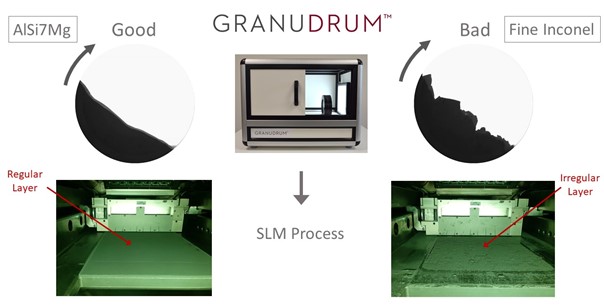
Figure 1 : General principle of how to relate GranuDrum measurements to powder performance inside an SLM printer
LEARN MORE ABOUT THE GRANUDRUM
Visual observation of layer homogeneity is usually the only way for operators to quantify the spreadability of powders during the recoating. However, relating the powder characteristics to its spreadability during the recoating process beforehand should provide a more cost-effective way to classify and select the optimal powder and recoating speed combinations.
The aim of this application note is to present how the characterization of the macroscopic properties of metallic powders can be related to their spreadability inside SLM printers. The spreadability of four metal powders have been determined with the GranuDrum, an automated rotating drum measurement method, whose cohesive index measurement has been shown to quantify the spreadability of the powder during the recoating process (see reference G. Yablokova et al. 2015). A new technique combining measurements inside a SLM printer and image processing have been developed to quantify the homogeneity of the powder bed layers during recoating.
The general principle of this study is summarized in figure 2: a low cohesive powder which show a smooth powder/air interface in the rotating drum will produce a more homogeneous layer inside the printer. On the opposite, a cohesive powder with bad flowing properties will exhibit an irregular interface in GranuDrum and non-homogeneous layer on the bed during the recoating.
GranuDrum
The GranuDrum instrument is an automated powder flowability measurement method based on the rotating drum principle. A horizontal cylinder with transparent sidewalls called drum is half filled with the sample of powder. The drum rotates around its axis at an angular velocity ranging from 2 rpm to 60 rpm. A CCD camera takes snapshots (30 to 100 images separated by 1s) for each angular velocity. The air/powder interface is detected on each snapshot with an edge detection algorithm. Afterwards, the average interface position and the fluctuations around this average position are computed. Then, for each rotating speed, the flowing angle (also known in the literature as ‘dynamic angle of repose’) αf is computed from the average interface position and the dynamic cohesive index σf is measured from the interface fluctuations.
LEARN MORE ABOUT THE GRANUDRUM
In general, a low value of the flowing angle αf corresponds to a good flowability. The flowing angle is influenced by a wide set of parameters: the friction between the grains, the shape of the grains, the cohesive forces (van der Waals, electrostatic and capillary forces) between the grains.

Sketch of GranuDrum measurement principle
The dynamic cohesive index σf is only related to the cohesive forces between the grains. A cohesive powder leads to an intermitted flow while a non-cohesive powder leads to a regular flow. Therefore, a dynamic cohesive index closes to zero corresponds to a non-cohesive powder. When the powder cohesiveness increases, the cohesive index increases accordingly. In addition to the measurement of both the cohesive index σf and the flowing angle αf as a function of the rotating speed, the GranuDrum allows to measure the first avalanche angle and the powder aeration during the flow.
In this application note, we focus on the cohesive index.
Powders Description
Four metallic powders provided by the Sirris were selected for this study: two Nickel alloys (Inconel®, Inconel® fine) and two Aluminium alloys (AlSi7Mg06, Scalmalloy®).
Particle size distribution is summarized in table 1:
| Powder | d10 (µm) | d90 (µm) |
|---|---|---|
| Inconel® Fine | 3.6 | 22 |
| Inconel® | 14 | 46 |
| AlSi7Mg06 | 20 | 63 |
| Scalmalloy® | 20 | 59 |
Visual Characterization
The recoating performance of the powders inside SLM printer have been evaluated experimentally with in situ observation of layer homogeneity performed by the Sirris in Belgium. After each deposition of a layer by the recoater, a picture is taken by a camera located inside the printer. An initial visual characterization can be made based on these pictures.
- AlSi7Mg06:homogeneous layer, with only small waves orthogonal to the recoater displacement. Also, the layer is more homogeneous at the highest speed (160mm/s) indicating an increase of spreadability with recoating speed.
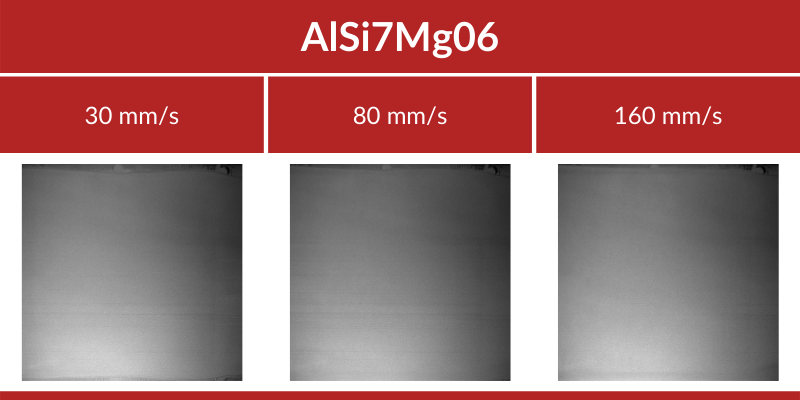
- Inconel®: homogeneous layer, with only very light parallel waves appearing at 160mm/s. This powder denotes a good spreadability.
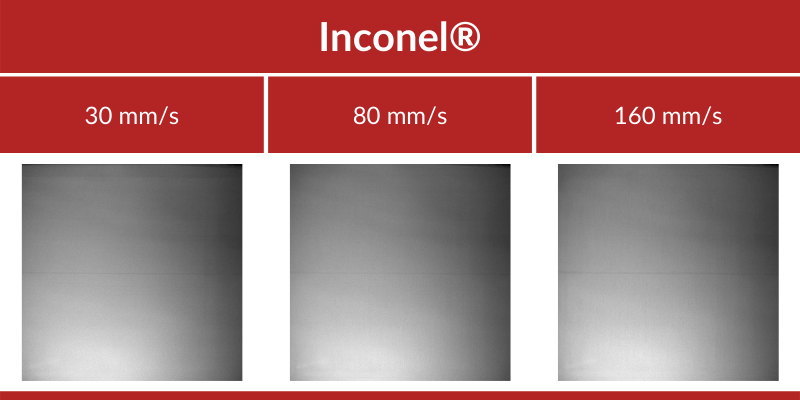
- Scalmalloy®: achieve a lower spreadability in comparison with AlSi7Mg06 and Inconel®. Indeed, at 80mm/s strong orthogonal waves are present together with light parallel waves. These parallel waves are more pronounced at 160mm/s, and thus Scalmalloy® perform better at low speed.
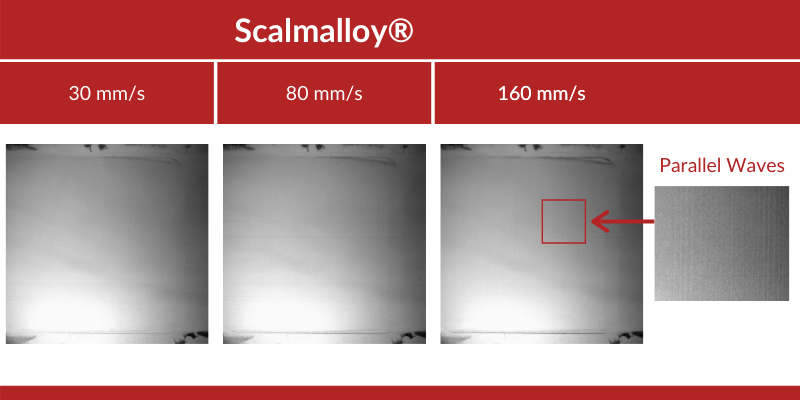
- Inconel® fine: Highly inhomogeneous layers. Even at low speed (30mm/s), the deposition of a homogeneous layer is impossible. This powder clearly demonstrates the worst spreadability.
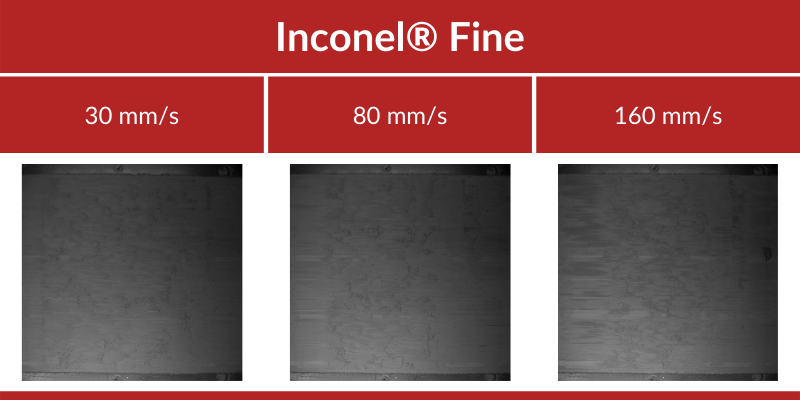
From these visual observations, it appears clearly that these powders show very different recoating performance.
GranuDrum Analysis
Experimental Protocol
For an experiment with the GranuDrum, powders were poured inside the measuring cell just after box opening. The quantity of powder used was approximately 50ml. Every powder was analysed under ambient conditions (35%RH and 23°C). GranuDrum velocities were investigated from 2 to 60rpm. For each velocity, 40 pictures were taken to increase the accuracy and repeatability of measurement. Powders were measured three times to see the reproducibility of the result. Error bars are showing the standard deviation with respect to the average value.
LEARN MORE ABOUT THE GRANUDRUM
Experimental Results
Figure 2 presents the Cohesive Index as a function of the GranuDrum increasing rotating speed, which can be related to the recoater speed (see appendix 1). The Cohesive Index is linked to the fluctuations of the interface (powder/air) position induced by cohesive forces (Van der Waals, Electrostatic and Capillary). Thus, as discussed in section I.2, it allows to quantify powder spreadability. For an ease of comparison, the three recoater speeds used in the in situ SLM printer measurements are also indicated in figure 2.

Figure 2: . A shear-thickening behaviour is observed for all the powders, especially above 40rpm
LEARN MORE ABOUT THE GRANUDRUM
Discussion
Over the explored velocity range, the Inconel® fine exhibits the higher cohesive index and thus the lower spreadability. This is due to the smallest particle size of this powder, leading to a higher cohesiveness. The AlSi7Mg06 powder exhibits the best spreadability at low speeds and is closely followed by the Inconel®. Scalmalloy® has a higher cohesive index than AlSi7Mg06 and Inconel®, and so a lower spreadability.
Moreover, all the powders have a shear-thickening behaviour for rotating speed above 40 rpm. This behaviour is characterized by an increase of the cohesive index with speed. Therefore, the spreadability is expected to decrease when the recoater speed is increased. Powders AlSi7Mg06 and Scalmalloy® are particularly affected contrary to the Inconel® which exhibits a moderate shear-thickening. This behaviour introduces a limitation for the upper limit of recoating speed, above which the spreadability will not be good enough to produce homogeneous layers of powder.
From these results, to achieve the fastest recoating speed while keeping a good spreadability inside the printer, a recoating speed close to the highest recoating velocity (160 mm/s) chosen in this study seems to be the best compromise for these powders.
Spreadability Assessments
Experimental Protocol
The powder spreadability classification obtained by the GranuDrum measurements can be compared with the real performance inside the printer. Yablokova et al. have shown previously that the spreadability inside the printer is directly related to the cohesive index, but only with visual investigation. In the following, a more qualitative estimation of the homogeneity of layers is detailed. The powder spreadability is experimentally evaluated using a camera placed inside a SLM printer. After each recoater operation, a picture is taken. For the same recoater speed, 15 layers are created and therefore, 15 pictures are taken as well. These pictures have been briefly commented in section III based on visual examination, a more qualitative and repeatable analysis is now presented.
The GranuLayer software has been specifically designed by GranuTools to quantify the inhomogeneity of the powder bed surface in the printer. We introduce the “interface fluctuation” as a measure of the inhomogeneity of the successive layers obtained by the recoating. The measurement principle is as follow:
- Each picture is analysed separately. The picture size is 1200 x 1200px.
- Horizontal and vertical pixel intensity profiles are extracted at discrete positions of the picture (see figure X).
- An average “smooth” profile is computed for each position (figure X).
- Interface fluctuation is then computed based on the deviation around the averaged profile, and then averaged over all positions.
- The process is repeated for all the images, and the interface fluctuation is average over the whole set of pictures.
![]()
![]()
Figure 3: Top: horizontal and vertical lines from which pixel intensity profiles are extracted. Bottom: pixel intensity profile (plain) and average profile (dashed) used to compute the interface fluctuation
Experimental Results
Figure 4 presents the interface fluctuation versus the recoater speed obtained with the image processing analysis:

Figure 4: Interface fluctuations as a function of recoater speed (in mm/s). The recoater speed effect is more pronounce for the Inconel® fine, as observed also in GranuDrum
Discussion
The homogeneity of layers is now quantified more precisely with the interface fluctuation parameter. Inconel® and AlSi7Mg06 shows the lower interface fluctuation, and thus the best spreadability inside the printer for all recoater speeds. As these powders are only little influenced by the recoater speed, processing at 160mm/s seems thus to be the optimal recoating velocity. These results are well correlated with the cohesive index obtained with the GranuDrum.
Indeed, the shear-thickening behaviour is weak below 160mm/s. Scalmalloy® exhibits a higher interface fluctuation due to the appearance of parallel waves during recoating, in accordance with a higher measured cohesive index. Finally, the Inconel® fine that has the higher cohesive index shows a higher interface fluctuation denoting a poor recoating performance for all speeds.
These results show that homogeneity of layers obtained during the recoating is directly related to the cohesive properties of the powder. Indeed, a more cohesive powder (higher cohesive index) leads to a higher interface fluctuation due to a lower spreadability.
Conclusion
- Spreadability of four metal powders have been investigated and compared to their real performance inside SLM printers.
- Cohesive index measurements have been correlated with an interface fluctuation parameter computed from pictures taken inside the SLM to relates the powder cohesiveness to the homogeneity of layers obtained during the recoating process.
- The classification of powders observed with GranuDrum can be correlated with the homogeneity of layers. The ability of a powder to produce regular layers is thus directly related to cohesiveness.
- Therefore, powder characterization with GranuDrum provide a useful classification of powders as well as determining the best recoater velocity to increase the printer process quality.
Acknowledgments
The authors would like to thank the Sirris (Olivier Rigo) for providing the powders and for performing all the 3D printing experiments.
References
Cascade of granular flows for characterizing segregation, G. Lumay, F. Boschin, R. Cloots, N. Vandewalle, Powder Technology 234, 32-36 (2013).
Combined effect of moisture and electrostatic charges on powder flow, A. Rescaglio, J. Schockmel, N. Vandewalle and G. Lumay, EPJ Web of Conferences 140, 13009 (2017).
Compaction dynamics of a magnetized powder, G. Lumay, S. Dorbolo and N. Vandewalle, Physical Review E 80, 041302 (2009).
Compaction of anisotropic granular materials: Experiments and simulations, G. Lumay and N. Vandewalle, Physical Review E 70, 051314 (2004).
Compaction Dynamics of Wet Granular Assemblies, J. E. Fiscina, G. Lumay, F. Ludewig and N. Vandewalle, Physical Review Letters 105, 048001 (2010).
Effect of an electric field on an intermittent granular flow, E. Mersch, G. Lumay, F. Boschini, and N. Vandewalle, Physical Review E 81, 041309 (2010).
Effect of relative air humidity on the flowability of lactose powders, G. Lumay, K. Traina, F. Boschini, V. Delaval, A. Rescaglio, R. Cloots and N. Vandewalle, Journal of Drug Delivery Science and Technology 35, 207-212 (2016).
Experimental Study of Granular Compaction Dynamics at Different Scales: Grain Mobility, Hexagonal Domains, and Packing Fraction, G. Lumay and N. Vandewalle, Physical Review Letters 95, 028002 (2005).
Flow abilities of powders and granular materials evidenced from dynamical tap density measurement, K. Traina, R. Cloots, S. Bontempi, G. Lumay, N. Vandewalle and F. Boschini, Powder Technology, 235, 842-852 (2013).
Flow of magnetized grains in a rotating drum, G. Lumay and N. Vandewalle, Physical Review E 82, 040301(R) (2010).
How tribo-electric charges modify powder flowability, A. Rescaglio, J. Schockmel, F. Francqui, N. Vandewalle, and G. Lumay, Annual Transactions of The Nordic Rheology Society 25, 17-21 (2016).
Influence of cohesives forces on the macroscopic properties of granular assemblies, G. Lumay, J. Fiscina, F. Ludewig and N. Vandewalle, AIP Conference Proceedings 1542, 995 (2013).
Linking compaction dynamics to the flow properties of powders, G. Lumay, N. Vandewalle, C. Bodson, L. Delattre and O. Gerasimov, Applied Physics Letters 89, 093505 (2006).
Linking flowability and granulometry of lactose powders, F. Boschini, V. Delaval, K. Traina, N. Vandewalle, and G. Lumay, International Journal of Pharmaceutics 494, 312–320 (2015).
Measuring the flowing properties of powders and grains, G. Lumay, F. Boschini, K. Traina, S. Bontempi, J.-C. Remy, R. Cloots, and N. Vandewalle, Powder Technology 224, 19-27 (2012).
Motion of carbon nanotubes in a rotating drum: The dynamic angle of repose and a bed behavior diagram, S. L. Pirard, G. Lumay, N. Vandewalle, J-P. Pirard, Chemical Engineering Journal 146, 143-147 (2009).
Mullite coatings on ceramic substrates: Stabilisation of Al2O3–SiO2 suspensions for spray drying of composite granules suitable for reactive plasma spraying, A. Schrijnemakers, S. André, G. Lumay, N. Vandewalle, F. Boschini, R. Cloots and B. Vertruyen, Journal of the European Ceramic Society 29, 2169–2175 (2009).
Rheological behavior of β-Ti and NiTi powders produced by atomization for SLM production of open porous orthopedic implants, G. Yablokova, M. Speirs, J. Van Humbeeck, J.-P. Kruth, J. Schrooten, R. Cloots, F. Boschini, G. Lumay, J. Luyten, Powder Technology 283, 199–209 (2015).
The flow rate of granular materials through an orifice, C. Mankoc, A. Janda, R. Arévalo, J. M. Pastor, I. Zuriguel, A. Garcimartín and D. Maza, Granular Matter 9, p407–414 (2007).
The influence of grain shape, friction and cohesion on granular compaction dynamics, N. Vandewalle, G. Lumay, O. Gerasimov and F. Ludewig, The European Physical Journal E (2007).


